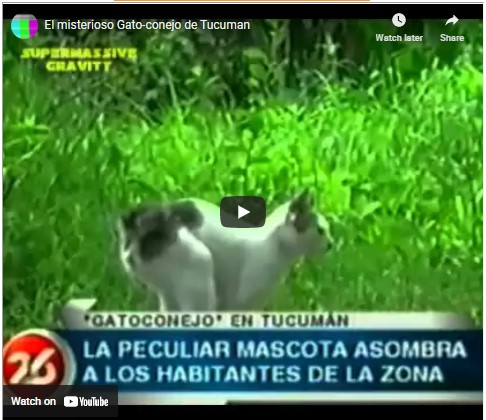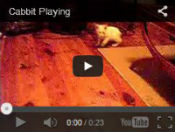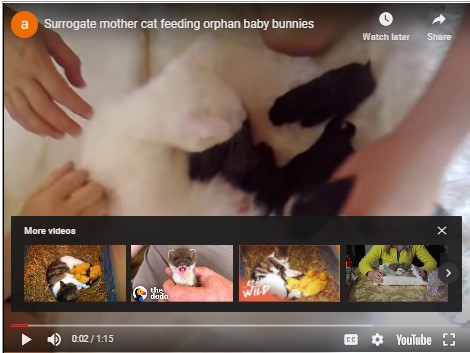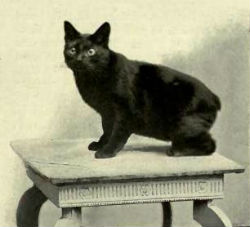Cat-rabbit Hybrids (Cabbits)
Mammalian Hybrids
This page was part of a draft for a chapter on this topic that has now been published in its finished form in my book Telenothians, which is available here.
|
“We learn to think about everything,” he said, “and then we train our eyes to look as we think about the things we look at.”
—Carlos Castaneda, A Separate Reality
|
(This article is part of the support material for the alternative theory of evolution offered on this website.)
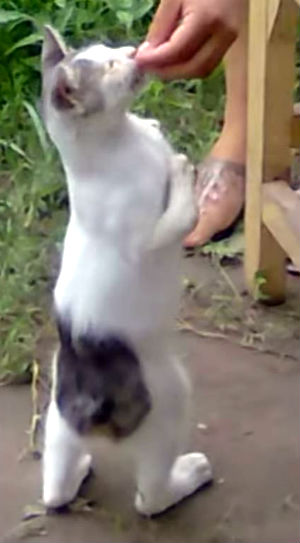 A screenshot from one of the many cabbit videos available on the internet. Note the plantigrade condition of the hind feet, which is normal for rabbits, but not cats. (Watch the video)
A screenshot from one of the many cabbit videos available on the internet. Note the plantigrade condition of the hind feet, which is normal for rabbits, but not cats. (Watch the video)
The alleged offspring of a buck rabbit and a cat is known as a cabbit (or rabcat), a creature with a long and contentious history. Many people consider such hybrids impossible, but it’s not as if evidence of their existence were lacking.
For example, there is a creature in Tucuman, Argentina, that seems to be an actual cabbit, not an impossible imaginary one. The following video clearly shows the Tucuman animal, in which the front half of the body looks just like that of a cat, and the rear half, just like a rabbit’s. It also moves around like a rabbit, not a cat. In short, it hops!
More cabbit videos >>
Reports describing cabbits >>
Do cabbits exist?
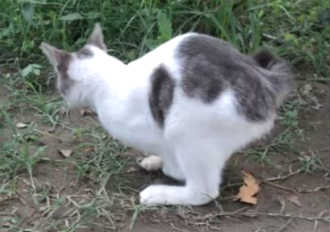 Picture of the Tucuman animal (see video above) showing plantigrade position of hind feet.
Picture of the Tucuman animal (see video above) showing plantigrade position of hind feet.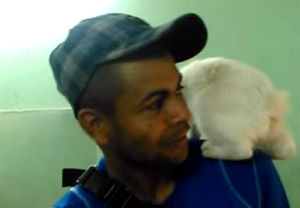 A screenshot from one of the cabbit videos collected on this website. Note the extreme similarity of the back half of this animal to a rabbit. And yet, as the video shows, its front half looks exactly like a cat. Is it a cabbit? Watch the video >>
A screenshot from one of the cabbit videos collected on this website. Note the extreme similarity of the back half of this animal to a rabbit. And yet, as the video shows, its front half looks exactly like a cat. Is it a cabbit? Watch the video >>
Not surprisingly, many have rejected, or even ridiculed, claims that cabbits exist. Thus, the nineteenth-century naturalist Francis Trevelyan Buckland, who believed all purported hybrids of this type to be “Manx cats with birth defects,” once joked (Buckland 1882, p. 33), “To Mr. [Abraham Dee] Bartlett [then Superintendent of the London Zoo], are brought sometimes
On the other hand, there are many, often vehement claims that cabbits are real. For example, Sarah Hartwell, who wrote an article arguing that cabbits are impossible, quoted the following from an email she received from a cabbit proponent: “I just read your article on your web page and have to tell you that you are full of crap. Cabbits are
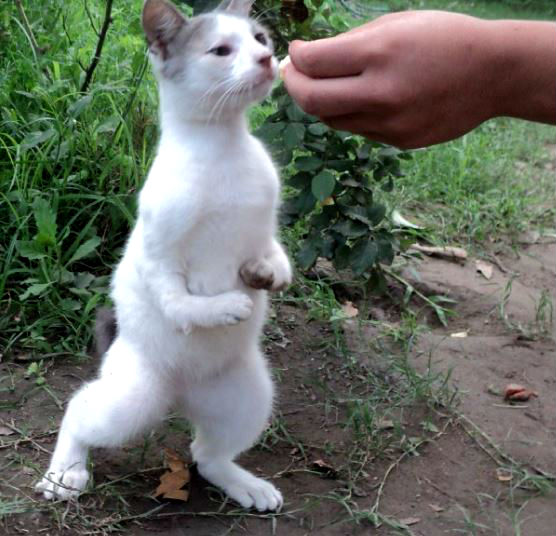 A frontal view of the same ostensible cabbit shown at the top of this page.
A frontal view of the same ostensible cabbit shown at the top of this page.
Thus, it seems that participants on both sides of this unending debate view their opponents as ignorant, and perhaps even intentionally dishonest. Originally, I myself dismissed the idea that such a distant hybrid might be possible. However, after seeing many of the videos on Youtube showing what appear to be living cabbits (quite a few of which can be seen here), I now wonder. I’d like to see some of these animals genetically tested, but no one with the proper laboratory facilities has chosen to do so.
It is certainly true, however, that buck rabbits have many times been observed to mount and mate with female cats. This fact is amply documented on YouTube. And numerous videos showing ostensible cabbits have been collected on a separate page of this website. All show “cats” that appear to be similar to a rabbit in the posterior regions of their bodies, and which hop like rabbits. Manx cats with birth defects? Cat-rabbit hybrids? Such evidence suggests, at the very least, that this issue should be investigated further. If these animals are hybrids, it would be easy to verify the fact via analysis of their DNA, given that they would, presumably, be F₁ hybrids. Only later-generation backcross hybrids raise difficulties in connection with DNA evaluation.
It’s significant that cats have been known to suckle and raise rabbits. Animals adopted by a female not of their own kind tend, upon reaching sexual maturity, to choose to mate with animals of that kind instead of their own (this phenomenon is known as imprinting). The result is often hybridization. The following video documents a case of a cat nursing rabbits:
Rabbits nursed in this way would no doubt be imprinted on cats when they reached maturity and therefore as adults, instead of mating with their own kind, would choose to mate with cats, a sine qua non of cabbit production (if cabbits can be produced at all!).
In the case of Manx cats, if they are of hybrid origin (see section on the origin of the Manx here), the rabbit parent in question would be Oryctolagus cuniculus, the European rabbit, which is the only rabbit occurring on the Isle of Man. As to the various ostensible cabbits shown on the cabbit videos page, it is uncertain whether the European rabbit or some other type of rabbit might have been involved. Oryctolagus cuniculus, however, which is highly invasive, has been introduced into many different parts of the world, and numerous rabbit breeds, closely allied to the European rabbit, are widely popular as pets.
Why some people say cabbits are impossible
CABBIT—Mrs. Norm Weiler of St. Petersburg, Fla., has a new pet, but she’s not sure what it is. The animal has the head and shoulders of a cat, and the body of a rabbit, while its voice is half growl, half meow. Mrs. Weiler, who adopted the creature when it wandered into her yard recently, calls her new pet “Cabbit.” She says it hates fish, loves cabbage and roast veal.
(This brief article was accompanied by the usual photo of a cabbit.)
Chromosomes. One reason people often cite for the impossibility of producing cabbits is that rabbits and cats have different chromosome numbers (2n=44 and 2n=38, respectively) and that they therefore cannot produce hybrids together. This claim, however, is not consistent with the fact that well-documented hybrids are known from many other types of mammalian crosses where the parents differ even more with respect to chromosome number than do a cat and a rabbit. Numerous cases of this sort are documented on this website. A few examples, among many, are:
The chromosome counts of sheep and goats differ by exactly six, just as do cats and rabbits, but it is well known that they occasionally produce hybrids.
My response: “Most enjoy a nice mouse and tuna casserole with plenty of lettuce and carrots, and perhaps a light, re-ingestible pellet topping.”
(More seriously, look at the end of the video at the top of the cabbit videos page, where one is seen eating a carrot and an avocado.)
Gestation period. A second argument is that the gestation period of a cat is a month longer than that of a rabbit (64 and 31 days, respectively), which is somehow supposed to make hybrids impossible. During the course of my research into hybrids, I have often met with this assertion. It is, in fact, an age-old claim, dating back at least as far as Pliny the Elder (1st century A.D.). But various counterexamples invalidate this line of argument. Two well-established examples are the cama, the hybrid of a dromedary camel (gestation period = 13 months) and a llama (g.p. = 11 months), and the wolphin, the hybrid of a false killer whale (g.p. = 15.5 months) and a bottle-nosed dolphin (g.p. = 11.5 months). Both of these cases are documented on this website (here and here, respectively). In the latter case, the gestation periods of the two animals in question differ, by four months, and not merely one, as in the case of cat and rabbit. The domestic pig has a gestation period of 115 days, whereas that of the babirusa averages 153 (150-157 days), a difference of 33 percent, about the same, then, as that between dolphins and false killer whales (34%). And yet, they produce hybrids. So it seems this claim about differences in gestation period lengths preventing hybridization is just an old wive’s tale, repeated by scientists and non-scientists alike.
|
Cabbits — by Chris Millar
Buck rabbit catRabbit bucks cat Buck rogers cat |
Genetic “distance.” A third is that they are too “different genetically” to produce hybrids. But every hybrid cross involves parents that are genetically different and the exact amount of genetic difference that precludes a hybrid cross is unknown, as is the nature of such differences. (I say this as a Ph.D. in genetics who has spent years researching hybrids.)
“Difference.” A fourth is that they are too different in terms of their anatomy or in terms of evolutionary relationship to produce a hybrid. But the parents in a hybrid cross typically differ in anatomy, and it is not known just how different two animals can be in terms of their anatomy and still produce a hybrid. As to evolutionary relationship, in that case too, it is unknown how distantly related two hybridizing animals can be. (But perhaps the present case, that of cat-rabbit hybrids, gives us a clue?)
Fertility. In the case of this specific cross some people point to the fact that Manx cats not only produce offspring, but are a recognized breed. Since hybrids are sterile, they say, the Manx cannot be a hybrid. Quod erat demonstrandum! However, this argument draws conclusions from false premises. Many hybrid crosses (documented elsewhere on this website) produce fertile, or at least partially fertile, offspring. And many fertile domestic breeds are known to be the products of hybridization. So there really is no reason to conclude on such a basis that Manx cats cannot be cat-rabbit hybrids.
The “Manx gene.” Indeed, Manxes are not as fertile as ordinary cats. It is well-known that they produce a high percentage of inviable offspring, which is characteristic of hybrids. This high rate of inviability is attributed to the "Manx gene." I have not found—and I challenge anyone else to find—any formal study characterizing this gene, or even mapping it to a particular chromosome.
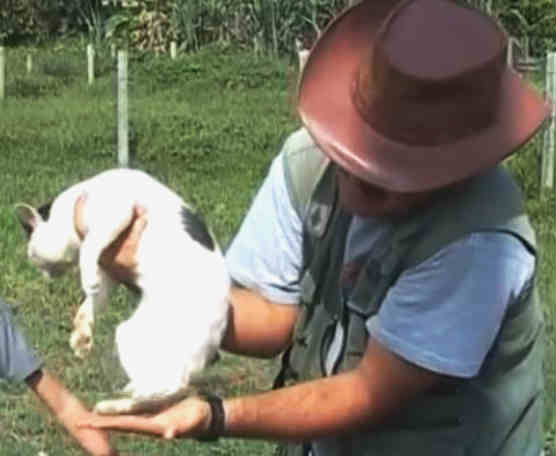 Another view of an ostensible cabbit, taken from a video on YouTube (watch the video here).
Another view of an ostensible cabbit, taken from a video on YouTube (watch the video here).
Two gametes meet and say hello.
Perchance their sum is apropos.
But in advance, you never know.
It has, of course, been noted that mating a tailless Manx with another tailless Manx results in a higher rate of inviable offspring than does mating a tailless Manx with a tailed one (Deforest and Basrur 1979). The last-cited authors state that in Manx cats such serious disorders as "spina bifida, urinary and faecal incontinence and locomotor disturbances of the pelvic limbs" are all associated with the tailless condition. But another explanation of this fact might be that tailless Manxes represent F₁ cat-rabbit hybrids and long-tailed Manxes represent backcrosses to pure cat. In many hybrid crosses mating F₁ hybrids with backcross hybrids increases the number of viable offspring (in comparison with F₁-F₁ matings).
Conclusion. So it’s true, one can suppose that Manx cats are the product of mutation and that they do not have any rabbit ancestry. But if one does make such an assumption, one must also suppose that that mutation (or series of mutations) happened to make the posterior half of the Manx look just like the posterior half of a rabbit, the little tail, the long, hopping legs, even the blunt, non-retractile claws. One must also assume that mutation is the reason that Manxes like to eat such things as carrots, lettuce and grass. One must also assume that all the disorders associated with Manx cats, mentioned in the preceding paragraph, are just coincidental side effects of the mutation process—mutations which, incidentally, have never been specifically identified or characterized at the genetic level. And one must assume that some professional breeder would be able to select, with time, from the descendants of an ordinary cat, hind features that appear identical to a rabbit through some unknown genetic change.
But that’s a lot to swallow. Are there any other known instances of breeders, even after many generations, converting the back half of an animal in such a way that it becomes identical to that of some other, wholly distinct animal? Isn’t it far simpler, far more straightforward, to assume that Manxes have these rabbit-like traits, that they are less fertile than ordinary cats, that they frequently produce inviable offspring, and that they are affected by the kind of dysfunctional traits seen in hybrids produced by distant crosses, because they are in fact cat-rabbit hybrids? As Samuel Johnson once said, “The solution as I have given it, is plain. Suppose, I know a man is so lame that
This page was part of a draft for a chapter on this topic that has now been published in its finished form in my book Telenothians, which is available here.
More cabbit videos >>
Reports describing cabbits >>
A list of cat crosses
The following is a list of reported cat crosses. Some of these crosses are much better documented than others (as indicated by the reliability arrow). Indeed, some might seem completely impossible. But all have been reported at least once. The links below are to separate articles. Additional crosses, not listed here, are covered on the cat hybrids page.
|
|
